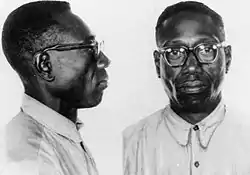Monroe Hickson | |
|---|---|
 FBI profile image of Monroe Hickson | |
| Born | July 8, 1908 |
| Died | December 29, 1967 (aged 59) |
| Other names | Willie Tyler "Bluecorns" |
| Conviction(s) | Murder (4 counts) |
| Criminal penalty | Life imprisonment |
| Details | |
| Victims | 4 |
Span of crimes | April – September 1946 |
| Country | United States |
| State(s) | South Carolina |
Date apprehended | For the final time on August 8, 1957 |
Monroe Hickson (July 8, 1908 – December 29, 1967), also known as Willie Tyler,[1] was an American serial killer who murdered four shopkeepers during a crime spree in Aiken County, South Carolina, in 1946. He only confessed to the murders eleven years later after being arrested for a separate offence; prior to his confession, another man was wrongfully convicted for two of the murders.[2]
Hickson was sentenced to four life terms for the murders. He escaped from prison in 1966, resulting in a nationwide manhunt and his name being added to the FBI Ten Most Wanted Fugitives list. He died in December 1967 before he could be apprehended.
Early life
Monroe Hickson was born on July 8, 1908, in Aiken County, South Carolina. Hickson, although lacking a formal education, was said to have been very intelligent, and was an avid reader of the Bible, regularly carrying one with him.[3] Hickson was convicted of his first crime in 1931, which was assault with intent to kill. He was sentenced to five years in prison and released early in 1933.[4] In 1937, Hickson was convicted of burglary and larceny and sentenced to one year in prison.[5]
Murders
Hickson is known to have committed his first murder on April 17, 1946, when he fatally shot David Garrett at Garrett's shop in Aiken.[2] Afterwards, he robbed the place and stole a pistol. 11 days later, on April 28, Hickson killed Edward and Mary Bennett, a married couple who were working at the grocery store they owned. Before he died, Edward exclaimed to police "A big negro shot me and robbed me". The three murders, which took place in a short amount to time, were quickly connected and a $2,500 reward was published for any information leading to an arrest.[6]
On September, 28, Hickson attacked Annie Wiseburg at her home, where he stabbed and bludgeoned her to death.[7] In October, Hickson struck again, this time attacking a female liquor store clerk with a brick, however, she survived. He was arrested shortly after the last attack, but was not linked to the previous crimes, and was sentenced to 20 years imprisonment.[3]
Wrongful conviction of L.D. Harris
During the investigation of the Bennett slayings, police were notified about L.D. Harris, who had left town for Nashville, Tennessee shortly after the murders. Harris, who was illiterate, was questioned without a lawyer, in which he confessed. In January 1947, Harris' case went to trial. His defense claimed that besides the confession, which they claimed was the result of pressure from higher authority, no other evidence linked Harris to the crime.[8]
Nevertheless, the jury found Harris guilty on all counts, and he was sentenced to death. His lawyers attempted to appeal his sentence by contacting the Supreme Court of South Carolina, but they found no basis that his confession was involuntary. In 1948, Harris appealed to the United States Supreme Court, and they noted several factors that made his confession involuntary; Harris had not been informed of his rights under South Carolina law, had no access to family or friends, and the persistence of the authorities.[8] As such of this, in June 1949, the Supreme Court voted 5–4 in favor that Harris' sentence should be reversed.[8] Afterwards, Harris was released from prison.[9]
Capture and escape
On August 8, 1957, Hickson was arrested after perpetrating another violent assault, in which he attempted to kill Lucy Hill Parker, leaving her with a serious head injury. In the subsequent interrogation, Sheriff Wyman Busch questioned Hickson about other crimes, after noticing patterns in Hickson's movements to unsolved murders in the area. After this, Hickson confessed to having perpetrated four murders in the Aiken area in 1946, but claimed he was drunk each time he committed the crimes.[2] Because of this, Hickson was forced in four consecutive life sentences for each of the murders.
On March 10, 1966, Hickson escaped Manning Correctional Institution in Columbia, South Carolina, where he had been serving his sentences. A federal warrant was issued the following month, but with no leads in sight, Hickson was added to the FBI Ten Most Wanted Fugitives list on February 17, 1967.[3] In 1968, a couple from Chapel Hill, North Carolina came forward with information, after identifying Hickson to a migrant farm worker named Willie Tyler[1] who had died on December 29. A positive identification was later made via fingerprinting.[10]
See also
References
- 1 2 "Wanted Fugitive Dies in Hospital". Associated Press. January 31, 1968. Retrieved August 26, 2022.
- 1 2 3 "Slaying Of 4 Aiken People Now Admitted". The Greenville News. August 20, 1957. Retrieved January 16, 2022.
- 1 2 3 "S.C. Man Wanted In Four Murders". The Daily Advertiser. March 1, 1967. Retrieved January 16, 2022.
- ↑ "MANY PRISONERS IN COUNTY JAIL". Aiken Standard. October 7, 1931. Retrieved August 26, 2022.
- ↑ "NUMBER OF CASES TRIED IN COURT". Aiken Standard. May 7, 1937. Retrieved August 26, 2022.
- ↑ "$2,500 Reward Posted For Aiken Slayer". Aiken Standard. May 8, 1946. Retrieved August 26, 2022.
- ↑ "Aiken Negro Charged With Four Murders". Columbia Record. October 3, 1957. Retrieved August 26, 2022.
- 1 2 3 "L.D. Harris". The National Registry of Exonerations. Retrieved January 16, 2022.
- ↑ "S.C. Drops Murder Case". Ohio Daily Express. September 2, 1949. Retrieved January 21, 2022.
- ↑ "243. Monroe Hickson". FBI. Retrieved January 16, 2022.